Gastronomy of Krk Island: A Culinary Journey Through the Golden Island
Table of Contents
Nestled in the heart of the Kvarner Bay in the northern Adriatic Sea, the island of Krk, often referred to as the “Golden Island,” is a treasure trove of culinary delights. They reflect its rich history, Mediterranean climate, and bountiful natural resources. Krk’s gastronomy is a vibrant tapestry woven from fresh, locally sourced ingredients, time-honored traditions, and a deep connection to the land and sea. This extensive exploration delves into the island’s culinary heritage, signature dishes, local ingredients, traditional recipes, dining experiences, and gastronomic events that make Krk a haven for food lovers.
The Foundations of Krk’s Gastronomy
Krk’s gastronomy is deeply rooted in the Mediterranean diet, celebrated for its health benefits and emphasis on fresh, seasonal ingredients. The island’s fertile soil, mild climate, and pristine Adriatic waters provide an abundance of high-quality produce, seafood, and herbs that form the backbone of its culinary identity. The gastronomy of Krk is a harmonious blend of simplicity and sophistication. Here traditional recipes passed down through generations meet modern interpretations, creating a dining experience that is both authentic and innovative.
The island’s strategic location in the Adriatic has shaped its cuisine through centuries of cultural influences. From the Illyrians and Romans to the Venetians and the noble Frankopan family, who ruled during the Middle Ages. Each culture left its mark, contributing to a diverse culinary landscape that celebrates the island’s natural bounty. Krk’s gastronomy is not just about food; it’s a celebration of the island’s history, community, and connection to the environment.
Signature Ingredients of Krk’s Cuisine
Krk Olive Oil: Liquid Gold
Krk’s extra virgin olive oil is a cornerstone of its culinary identity, often described as “liquid gold” for its quality and flavor. It is produced from indigenous olive varieties such as Debela, Drobnica, Rošulja and Plominka. Krk olive oil is extracted solely through mechanical processes, ensuring purity and richness. Since 2016, it has been a protected Croatian product at the EU level, recognized as one of the finest Mediterranean oils. Its flavor profile ranges from fruity and mild to slightly peppery, making it a versatile ingredient in salads, seafood dishes, and even desserts. Visitors can explore olive groves, visit oil mills, and participate in tastings to appreciate its nuanced flavors. Some producers infuse olive oil with local lavender or lemon, creating unique pairings for fish and vegetables.
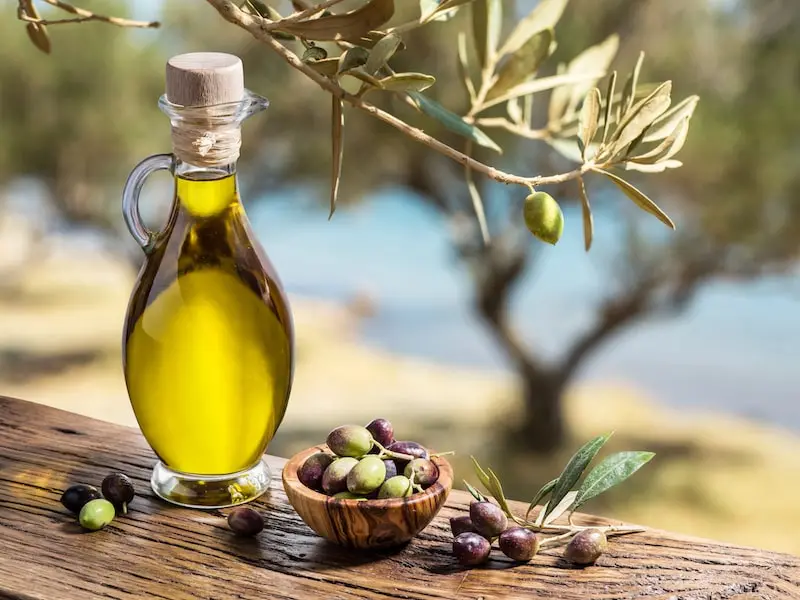
Krk Prosciutto: A Protected Delicacy
Krk prosciutto (pršut) holds the distinction of being the first Croatian product to receive EU protection for its geographical indication. Cured with wild island herbs and dried in the bora wind, this prosciutto is not smoked, allowing its natural flavors to shine. The result is a tender, buttery texture with a delicate, savory taste. The House of Krk’s Prosciutto offers tours and tastings. Here visitors can learn about the traditional salting and drying process influenced by the island’s unique microclimate. Often served as an appetizer with sheep cheese and olives, Krk prosciutto is a must-try delicacy.
Krk Cheese: A Taste of Tradition
Krk cheese, particularly its sheep’s milk variety, is an autochthonous product crafted on family farms. This hard, full-fat cheese is made from the milk of sheep that graze on pastures rich with medicinal herbs, imparting a distinctive flavor. Recognized for its quality, Krk sheep cheese is often enjoyed as an appetizer or grated over pasta dishes. Cow and goat cheeses are also produced, offering a range of flavors from mild to robust. Visitors can explore family cheese farms for tastings and insights into traditional production methods.
Vrbnička Žlahtina: The Noble Wine
The island’s viticultural star is Vrbnička Žlahtina. It is a dry white wine made from an indigenous grape variety grown exclusively in the Vrbnik field. Its pale yellow hue, delicate aroma, and crisp, fresh taste make it a perfect companion for seafood and lamb dishes. The name “Žlahtina” derives from the Slavic word for “noble,” reflecting its esteemed status. Vineyards in Vrbnik, such as those operated by the Vrbnik Agricultural Cooperative, offer tours and tastings, and some producers have experimented with aging Žlahtina underwater for unique flavor profiles. Other local wines, including Istrian Malvazija and rosés, complement Krk’s culinary offerings.
Seafood: Gifts of the Adriatic
The clean waters of the Adriatic provide Krk with an abundance of fresh seafood, including monkfish, squid, shrimp, mussels, and Kvarner scampi. These are prepared in various styles, from grilled with olive oil to slow-cooked in a brudet (fisherman’s stew). Fried sprats and anchovies, once staples of the island’s diet, remain popular at fishermen’s festivals and taverns. The rocky coastline and fresh water sources create ideal conditions for marine life, ensuring exceptional quality.
Krk Lamb: A Legendary Delicacy
Krk lamb is renowned for its unique flavor, attributed to the sheep’s diet of aromatic herbs and salty grasses. Legend has it that Krk lamb was served at Emperor Nero’s feasts in Rome, a testament to its historical prestige. Whether grilled, skewered, or slow-cooked under a bell-shaped lid (peka), Krk lamb is a highlight of the island’s cuisine. Often it is paired with Vrbnička Žlahtina for a quintessential Krk experience.
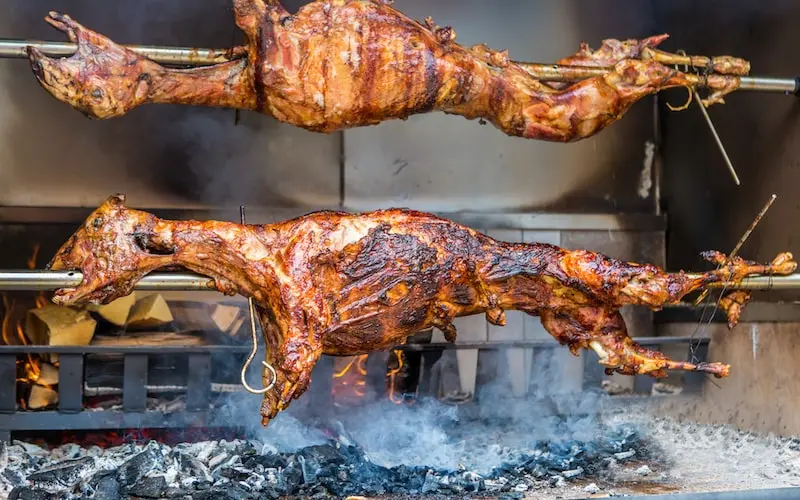
Homemade Pasta: Šurlice and Makaruni
Šurlice, a handmade pasta, is a gastronomic trademark of Krk. Traditionally served with lamb or beef stew, šurlice is now paired with diverse sauces, including wild asparagus, zucchini, scampi, or truffles. Making šurlice requires skill and patience, as the dough is rolled around a wooden stick to create its distinctive shape. Makaruni, another traditional pasta, is similarly versatile. Both are celebrated at gastronomic events like Šurlice Days in July.
Wild Asparagus and Figs
Wild asparagus, hand-picked from Krk’s slopes in spring, is a cherished ingredient in pasta dishes, omelets, and risottos. Figs, both fresh and dried, are integral to Krk’s cuisine, appearing in desserts like smokvenjak (a fig-based treat) and jams. These ingredients reflect the island’s agricultural heritage and are celebrated at events like Fig Days.
Iconic Dishes of Krk
Appetizers
- Krk Prosciutto and Cheese Platter: A classic starter featuring thinly sliced prosciutto, sheep cheese, olives, and bread drizzled with Krk olive oil.
- Marinated Anchovies and Sprats: Lightly fried or marinated in olive oil and vinegar, these small fish are a traditional coastal delicacy.
- Maneštra: A hearty vegetable stew that showcases the simplicity of Mediterranean ingredients, often served with homemade bread.
Main Courses
- Šurlice with Lamb Stew: Handmade šurlice pasta served with a rich lamb stew, flavored with rosemary, laurel, and garlic.
- Brudet (Fish Stew): A savory stew made with a mix of fish and seafood, such as conger, prawns, and mussels. It’s cooked with tomatoes, wine, and herbs. Best enjoyed with polenta.
- Grilled Seafood Platter: Freshly caught fish, squid, and scampi grilled with olive oil and herbs, served with Swiss chard and potatoes.
- Krk Lamb Peka: Slow-cooked lamb under a peka (bell-shaped lid) with potatoes and vegetables, infused with the flavors of wild herbs.
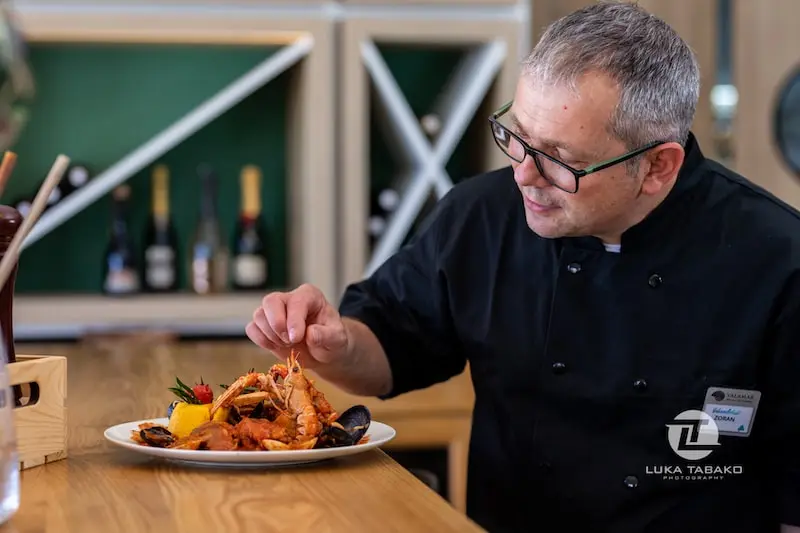
Desserts
- Presnac/Presnec/Presnoc: A traditional sheep cheese cake with a creamy filling, its name varying by region. This dessert is a beloved part of Krk’s culinary heritage.
- Smokvenjak: A rustic dessert made from figs, almonds, and grape must, reflecting the island’s Mediterranean roots.
- Krčka Kneginja (Krk Princess): A modern cake inspired by 15th-century Frankopan court recipes, blending local ingredients like figs and nuts.
- Fritule and Kroštule: Fried dough balls (fritule) dusted with powdered sugar and thin, crispy pastries (kroštule), often served during holidays.
- Imbriagon (Imbrijagoni): A fragrant, wine-soaked biscuit unique to Krk town, traditionally prepared for festive occasions.
- Gelati d’Oro: Artisanal ice cream made with local ingredients, available in classic, vegan, and gluten-free varieties, named after Krk’s Roman moniker, “Isola d’Oro.”
Where to Savor Krk’s Cuisine
Krk’s culinary scene thrives in its konobas (traditional taverns), restaurants, and family-run establishments. Here are some standout dining spots:
- Bistro Bukarica by Grotto (Malinska): A charming bistro in Malinska offering a delightful mix of traditional Krk dishes, such as šurlice with seafood and grilled lamb, served in a cozy, grotto-inspired setting with a focus on fresh, local ingredients.
- Konoba Nada (Vrbnik): Renowned for its wine cellar and sea-view terrace, this konoba serves seafood, šurlice, and Krk prosciutto, paired with Vrbnička Žlahtina. Its shop offers local olive oil and wines.
- Restaurant Rivica (Njivice): Considered one of the best seafood restaurants on Krk, it uses fish caught with its own nets, offering dishes like grilled octopus and brudet in a charming setting.
- Konoba Pud Brest (Milohnići): A rustic restaurant known for wood-fired dishes, including lamb peka and seafood, emphasizing farm-to-table ingredients.
- Villa Rova (Malinska): A fine-dining venue by the sea, specializing in seafood and Krk lamb, with a focus on local wines and olive oil.
- Konoba Andreja (Vrbnik): Praised for its terrace views, fresh seafood, and high-quality ingredients, this spot is ideal for a memorable meal.
For a truly immersive experience, visit local konobas, which offer rustic charm and family recipes. Many restaurants provide vegetarian, vegan, and gluten-free options, reflecting Krk’s commitment to diverse dietary preferences.
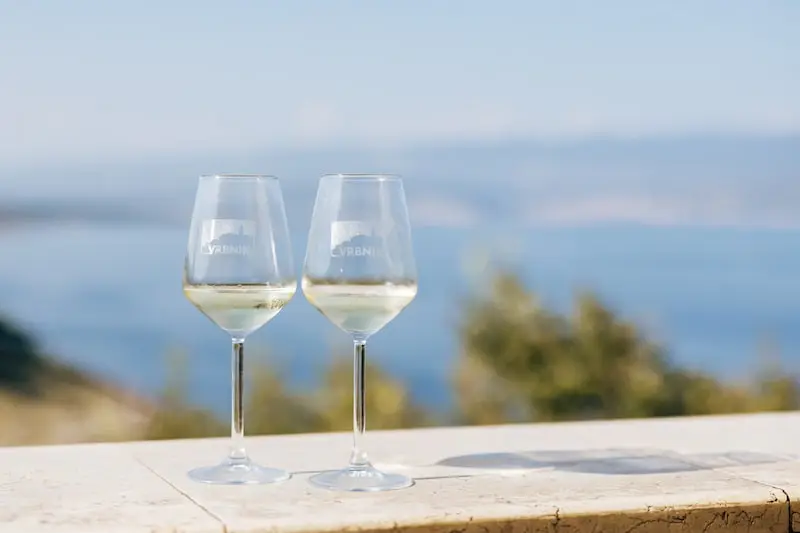
Gastronomic Events and Experiences
Krk’s culinary calendar is packed with festivals that celebrate its food and wine:
- Wine Days (Vrbnik): Held annually, this event showcases Vrbnička Žlahtina with tastings, cellar tours, and food pairings.
- Fig Days (August/September): Restaurants across the island highlight figs in dishes and desserts, from jams to smokvenjak.
- Šurlice Days (July): A summer celebration of handmade pasta, featuring creative dishes.
- Lamb Days (May): A tribute to Krk’s lamb, with tastings and traditional preparations.
- Black Sheep Festival: A celebration of Krk’s renowned lamb, featuring tastings, cooking demonstrations, and dishes highlighting the island’s prized ingredient, typically held in spring.
- Food Truck Festival: A vibrant event bringing together mobile eateries offering creative takes on Krk’s traditional dishes, alongside international street food, usually occurring in summer.
- Olive Days: A tribute to Krk’s extra virgin olive oil, with tastings, olive grove tours, and workshops on olive oil production, held during the harvest season in late autumn.
- Fishermen’s Festivals: Held in coastal towns, these events feature fried sprats, anchovies, and seafood platters, often accompanied by live music.
Visitors can also join culinary tours, such as the 7-day “Taste Krk” experience, which includes olive oil tastings, prosciutto factory tours, cheese farm visits, and šurlice-making classes. Exploring local markets in towns like Krk and Vrbnik offers a chance to sample fresh produce, cheeses, and jams.
Culinary Experiences Beyond the Plate
Krk’s gastronomy extends beyond dining to immersive activities:
- Olive Oil Tastings: Visit Nono Olive Oil House or local groves for guided tastings and tours of olive mills. Here you can learn about cultivation and pressing techniques.
- Wine Tours in Vrbnik: Explore vineyards and wineries to sample Žlahtina and learn about Krk’s viticultural history. Some tours include pairings with local cheeses and prosciutto.
- Prosciutto and Cheese Farms: The House of Krk Prosciutto and family-run cheese farms offer insights into traditional production methods, complete with tastings.
- Cooking Classes: Learn to make šurlice or traditional desserts like presnac at workshops offered by local konobas or tour operators.
- Farm-to-Table Experiences: Many restaurants and farms invite guests to participate in harvesting olives or asparagus, connecting diners with the island’s agricultural roots.
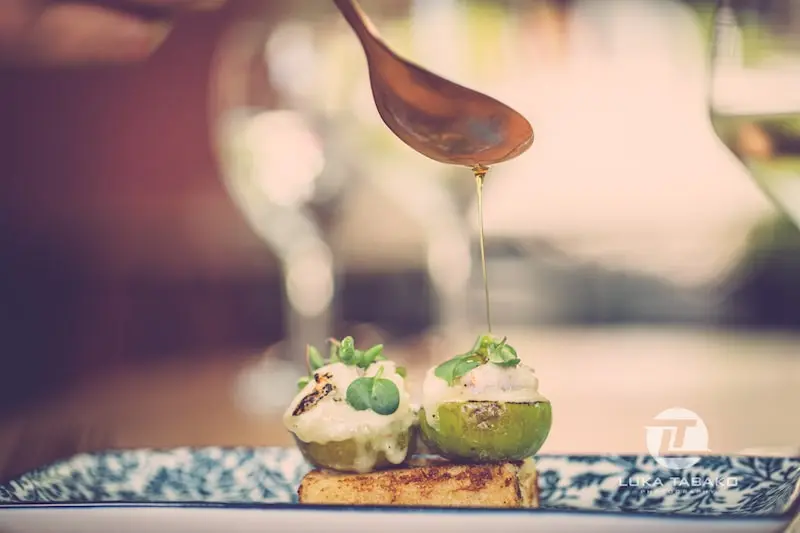
The Cultural Significance of Krk’s Gastronomy
Krk’s gastronomy is more than food—it’s a reflection of the island’s history and hospitality. The tradition of offering homemade brandy (rakija) and dried figs to guests symbolizes a warm welcome and a wish for a long, happy life. The island’s epithets, such as the Roman “Shiny Town of the People of Krk” and the Venetian “Happy and Golden Island,” underscore its historical wealth, much of which is expressed through its food. The Frankopan family, who ruled Krk in the Middle Ages, left a legacy of refined culinary traditions, evident in dishes like Krčka Kneginja.
Krk’s gastronomy also plays a central role in its tourism. Restaurants and konobas emphasize local ingredients, supporting small producers and preserving traditions. The use of wild herbs, olive oil, and sea salt in nearly every dish reflects Krk’s deep connection to its environment, while its festivals foster a sense of community and pride in local heritage.
Practical Tips for Exploring Krk’s Gastronomy
- Reservations: Popular restaurants like Konoba Nada and Restaurant Rivica can be busy, especially in summer. Book ahead to secure a table, particularly for terrace seating.
- Seasonal Menus: Many restaurants offer seasonal dishes, such as wild asparagus in spring or figs in late summer. Ask for daily specials to experience the freshest ingredients.
- Wine Pairings: Pair seafood with Vrbnička Žlahtina and lamb with a robust red like Teran from nearby Istria. Local sommeliers can guide you to the best pairings.
- Gastronomic Tours: Book tours through operators for curated experiences, including tastings and farm visits.
- Local Markets: Visit markets in Krk town or Vrbnik for fresh produce, cheeses, and homemade jams. These are ideal for souvenirs or self-catering.
- Vegetarian/Vegan Options: Many establishments offer plant-based dishes, such as maneštra or vegetable-based šurlice, catering to diverse diets.
Conclusion
Krk’s gastronomy is a celebration of the island’s natural bounty, historical richness, and warm hospitality. From the golden hues of its olive oil to the crisp notes of Vrbnička Žlahtina, every bite and sip tells a story of tradition and passion. Whether dining in a rustic konoba, savoring lamb under the peka, or exploring vineyards in Vrbnik, visitors to Krk are invited to embark on a culinary journey that engages all the senses. With its vibrant festivals, authentic ingredients, and welcoming atmosphere, Krk’s gastronomy is an integral part of its allure. It ensures that no one leaves the Golden Island hungry—or without a newfound appreciation for its flavors.
Bon appétit, or as the locals say, Dobar tek!
If you need help organising your activities or booking the best tours to explore the island and it’s surrounding, feel free to contact us. If you need a place to stay, check out our selection of accommodation on the island of Krk.